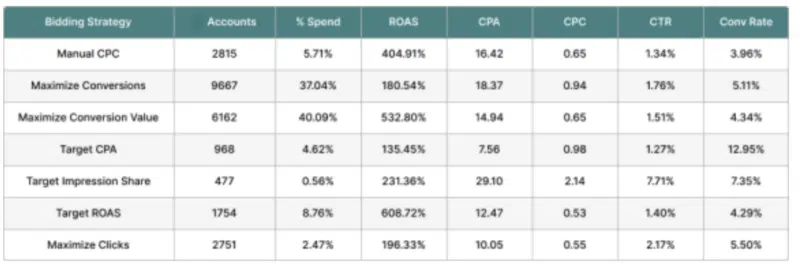There is no ‘best’ Google Ads bidding strategy, study finds
Max Conversion Value consistently delivers better ROAS and CPA compared to other Google Ads strategies, while Max Clicks is a strong but underutilized option.
That’s just one interesting finding from a new analysis conducted by Optmyzr, a PPC management platform.
Why we care. Choosing the right bidding strategy is crucial for maximizing ad performance, but conflicting advice and updates on the choices available make it tough to determine the best path.
Key questions analyzed.
- Which is the best overall bidding strategy: Smart, Auto or Manual bidding?
- Do bidding strategy targets help improve campaign efficiency?
- Do bid caps help improve campaign efficiency?
- What are the real conversion thresholds for optimal performance?
- Does spending influence the success of a bidding strategy?
- What percentage of advertisers use more than one bidding strategy?
More key findings.
- Advertisers using Manual CPC tend to see weaker CPA, CTR and conversion rates, despite its decent ROAS.
- Setting bidding strategy targets often hurts performance and bid caps show inconsistent impact.

By the numbers. Higher spend doesn’t guarantee success; Manual bidding alone improves with increased budgets.
- 48% of advertisers use multiple bidding strategies within the same account.
- Accounts with 50+ conversions in 30 days show the best performance across all strategies.
What to consider when testing. Here are a few key points to consider when diving into bidding strategy testing:
- No “best” strategy: There’s no universal bidding strategy that’s better than others (Smart, Auto, or Manual); success depends on execution and the account’s conversion volume.
- Early-stage accounts: Manual and Auto bidding strategies work well in the early stages since they aren’t reliant on conversions, helping advertisers understand auction prices.
- Smart bidding and conversion threshold: Smart bidding can be effective once an account has reached at least 50 conversions in a 30-day period, regardless of budget. Higher budgets don’t guarantee better performance—low-budget accounts sometimes outperform high-budget ones.
- Conversion data matters: Accounts with more conversions (50+) perform better, even when using Manual bidding, in terms of CPA, ROAS, CPC and CTR. For lower-conversion accounts, using micro-conversions can help in Smart bidding, but advertisers must assign accurate values to each action for better budget allocation.
- Budget and bidding strategy – Manual bidding correlates linearly with budget size, while other strategies face performance issues with drastic budget changes. Budget adjustments in Smart bidding require 2-3 weeks for performance stabilization.
- Bid caps, floors and targets: Setting goals like bid caps and floors can either help or hurt performance, often due to human error. Keeping bid caps within 10% of the daily budget helps ensure enough clicks per day and prevents underserving or misallocating the budget.
The analysis. Optmyzr reviewed Google Ads bidding strategies across 14,584 accounts that spent between $1,500 and $5 million per month. You can read the full analysis here: The Impact of Bidding Strategies on Google Ads Performance
What next. Optmyzr’s data-driven analysis offers actionable insights for marketers. Advertisers should test strategies based on conversion volume and remain cautious with aggressive budget or goal changes.